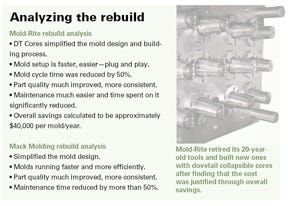A case can now be made, both on financial return and technical advantages, for retiring an existing unscrewing mold in favor of one with a collapsible core.Unscrewing molds are usually built for many years of production, as they are considered a long-term investment for the production of millions of parts. These are among the most complex of all injection molds, and require the highest amount of expertise both to build and maintain.
June 16, 2010
A case can now be made, both on financial return and technical advantages, for retiring an existing unscrewing mold in favor of one with a collapsible core.
Unscrewing molds are usually built for many years of production, as they are considered a long-term investment for the production of millions of parts. These are among the most complex of all injection molds, and require the highest amount of expertise both to build and maintain.
Though many leading moldbuilders have evolved their standards over the years, in general, there are still maintenance issues such as broken rollers, damaged racks, water and oil leaks, dropped racks, and so forth. Add to that common part quality issues such as scuffing, ovality, flash, and grease contamination, and it’s no wonder that companies often look to a “jump-thread” approach to eliminate the issues of unscrewing molds, or they explore collapsible cores as an alternative.
|
Recently there’s been an evolution of the standardization of the collapsible core approach. This method is now justifying handing a pink slip to an existing unscrewing mold—even one capable of running for the required years ahead—in favor of a new, fully mechanical collapsible core tool.
A radical move?
Shelving or gutting an existing, functioning mold may seem like a radical move in these conservative, cost-conscious times, but it’s exactly the desire for more profits that’s driving people to do the math. One can calculate the return on rebuilding a tool, or at least on salvaging the cavity half and rebuilding the core half, in order to gain returns that outweigh the capital expenditure.
For example, Mold-Rite Plastics Inc. (Plattsburgh, NY) builds and runs molds for its proprietary line of caps and closures. Recently it took a look at the future of two tools with 20 years of service that still had years of production ahead. Rather than simply keeping the tools going indefinitely, they did the math and were able to isolate the savings of converting to mechanical, dove-tail-style collapsible cores developed by Roehr Tool Corp. (Hudson, MA).
The goal for this project was to replace the existing molds with new technology in order to gain tooling with simpler operation, less maintenance, and shorter cycles. Phil Titherington, senior design engineer and toolroom manager at Mold-Rite, learned about the DT Series Collapsible Core from Roehr just as he was beginning to explore his options for replacing a 12-cavity tool to mold a 38-mm cap and a 24-cavity tool to mold a 24-mm cap.
“I was looking at collapsible core options from various suppliers, but when I heard about the DT Series, I sent Roehr drawings for the two projects,” explains Titherington. “Technical support was excellent, as we were provided info with the first mold so that we would learn proper handling, disassembly, and assembly of the cores, as well as installation of the cores into the mold base. By the time we built the second tool, everything went very smoothly without the need for assistance.”
The new standard product developed by Roehr converts what would have been a complex tool to an open/shut mold. Titherington also emphasizes the ease of mold setup, removability of the cores while the mold is in the press, and ease of maintenance. A final determining factor was greaseless operation. “It’s a cleaner process, making it a lot less susceptible to contamination, which is a chief concern for us on the production floor,” he says.
Calculating the savings, Mold-Rite confirms that investment in new tooling using DT Core technology was the right move.
Maintenance goals surpassed
Mack Molding (Arlington, VT) recently had the opportunity to quote the replacement of two four-cavity unscrewing molds used to manufacture PVC seal nuts, roughly 1.25 and 2 inches in diameter. The older molds, which were run by another molding company, had a history of excessive downtime, an issue attributed to their unscrewing cores.
Before quoting the project, Mack knew any maintenance costs incurred within the first million cycles would be their burden, as the OEM customer would not be held responsible. Mack was apprehensive about building the new molds using the same unscrewing methods, as the same maintenance issues could arise with the new tooling.
Rather than using flexing-steel-style collapsible cores, stainless steel was required due to molding PVC, and Roehr was able to provide this with its DT Cores. This approach gave Mack engineers the confidence they needed to introduce new designs to the customer for more robust and reliable tools, and reduced exposure to extensive mold maintenance expense.
Mack selected Carlson Tool & Mfg. Corp. (Cedarburg, WI) to build the new tools, and the moldmaker found them to be “very simple molds to design because they didn’t have a complex unscrewing system,” says Brian Wagner, engineering manager at Carlson Tool. “The simplicity was also apparent in the moldbuilding process. We were excited to be involved in a project that didn’t have unscrewing but gave us such a great outcome.”
Eliminating the gears, racks, and the cylinder superstructure of an unscrewing mold resulted in the use of a smaller mold base and fewer moving parts. A final review showed notable gains in mold efficiency and productivity over traditional unscrewing methods.
“The OEM customer verified that part quality was much improved and more consistent, thus requiring less destructive testing,” states Jeff White, senior account manager at Mack Molding. “Ease of maintenance was also a selling point. Because of how they are constructed, the DT Cores can even withstand welding for repairs or revisions.”
“From a production standpoint, we have been able to mold complex internal threads very efficiently as a result of the collapsible cores,” says Gene Birmingham, manufacturing manager at Mack’s Cavendish, VT facility. “Eliminating complex unscrewing mechanisms and additional sequencing saves time and helps us meet our customer’s production schedule.”
“The simple fact is that the math works,” states David Fowler, president of Windspeed Inc. (St. Thomas, ON). “Cycle time is reduced and maintenance cost is lowered.” Fowler is a seasoned toolmaker with 40 years of experience, and is now a consultant specializing in tool and part design. “I’ve worked with clients using collapsible core technology for many years. The benefits of a simpler mold design, faster sequence, and less stress on the part itself results in increased profits for the molder.”
Roehr says this new approach also allows for removing the entire core stack while the mold is in the press—impossible with rack and gear systems. This factor alone—eliminating an unscheduled mold pull and increasing cavity utilization—can drive the decision to retire an existing unscrewing tool. a
Alan Hickok is Midwest and OEM sales manager with mold component supplier Progressive Components and David Helenius is engineering manager at sister company Roehr Tool.
About the Author(s)
You May Also Like




